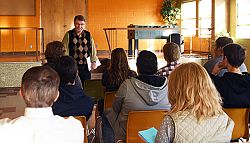Newman Center celebrates canonization of its namesake

LOGAN — The canonization of Cardinal John Henry Newman by Pope Francis was “an excuse to have cake and celebrate” for the Utah State University Newman Club, said the club’s president, Grace Gibbons.
“We’ve all kind of loved John Henry Newman for a long time because he’s our namesake. I believe there’s a lot of power in a name,” Gibbons said.
The USU Newman Club, which has about 35 active members, hosts a monthly dinner and weekly activities that include a Bible study and movie night. However, they gathered on Oct. 13 – the day of the canonization – for a special celebration that included a presentation on St. John Henry Newman that preceded the regular evening Mass at St. Jerome Chapel in Logan. Fr. Fernando Velasco, pastor of St. Thomas Aquinas Parish, presided at the Mass, which was followed by a social gathering that celebrated the canonization.
In his opening remarks, Fr. Velasco mentioned the canonization and that the newly canonized saint is the namesake of the Newman Center, and he asked for prayers for the members of the Newman Center.
The presentation on St. John Henry Newman was given by Richard Sherlock, a professor of philosophy at Utah State University and a convert to Catholicism.
Sherlock spoke of Newman’s early influences, including the secular philosophers David Hume, Voltaire and Thomas Paine, and his exploration of Calvinism.
In 1822 Newman graduated from Oxford University, “and for those of you who don’t think of yourselves as very good students, John Henry Newman is for you. He became one of the great minds of the 19th century but he graduated from Oxford College with about a C+ average in today’s grade,” Sherlock said.
Two years after graduating, Newman became a deacon in the Anglican Church; a year later he was ordained a priest, “and for the next 20 years … he was a strong Anglican. Very strong,” Sherlock said.
Around 1830 Newman began reading the Catholic Church’s Patristic Fathers. He then joined the Oxford Movement, which was an attempt to move the Anglican Church’s rituals and beliefs closer to the Catholic Church. In 1845 he was received into the Catholic Church; the following year, in Rome, he was ordained a priest by Pope Pius IX. Although he was never ordained a bishop, he was elevated to the rank of cardinal in 1879.
“During his life, Newman wrote a lot of sermons that are just beautiful,” as well as “four great books,” Sherlock said. One of those books was “The Idea of a University,” which described his philosophy of education.
These days, there are more than 2,000 Newman Centers in the United States, named after the saint.
For USU sophomore Nick Sauer, “The Newman Center is great because it’s an entire faith community of people just our age – all Utah State, so there’s the Aggie community already, and then you include the Catholicism in it and it’s just a great place to make friends who share your beliefs,” he said.
Newman Center activities such as the presentation are “an opportunity to exercise those beliefs; when we come together with each other just sharing cake and having fun, that community is the best way to spread God’s love,” Sauer said, adding that “I’m a philosophy major, so I love Cardinal Newman and everything he did and all he said about wisdom and education and how they’re related.”
© Copyright 2024 The Diocese of Salt Lake City. All rights reserved.

Stay Connected With Us